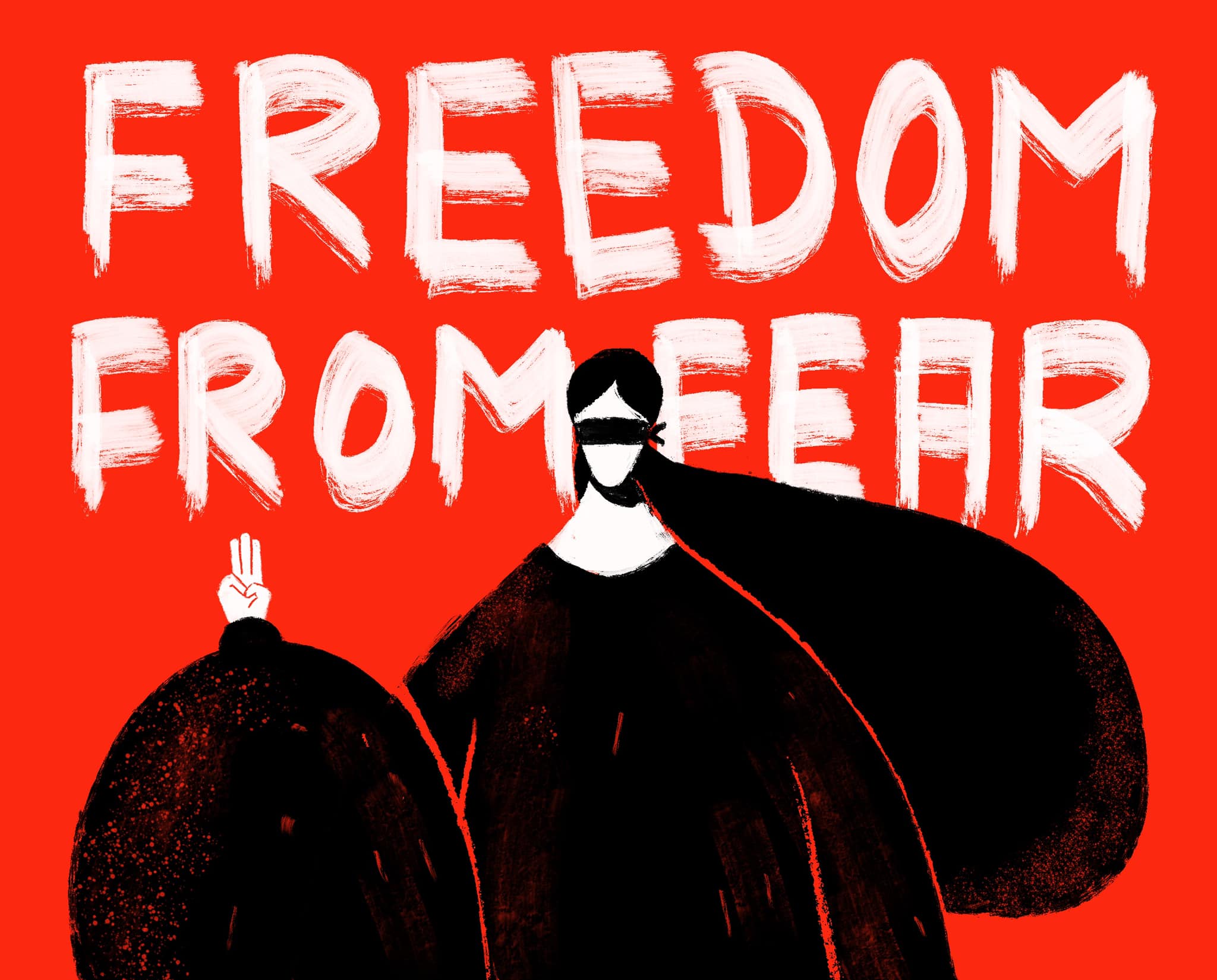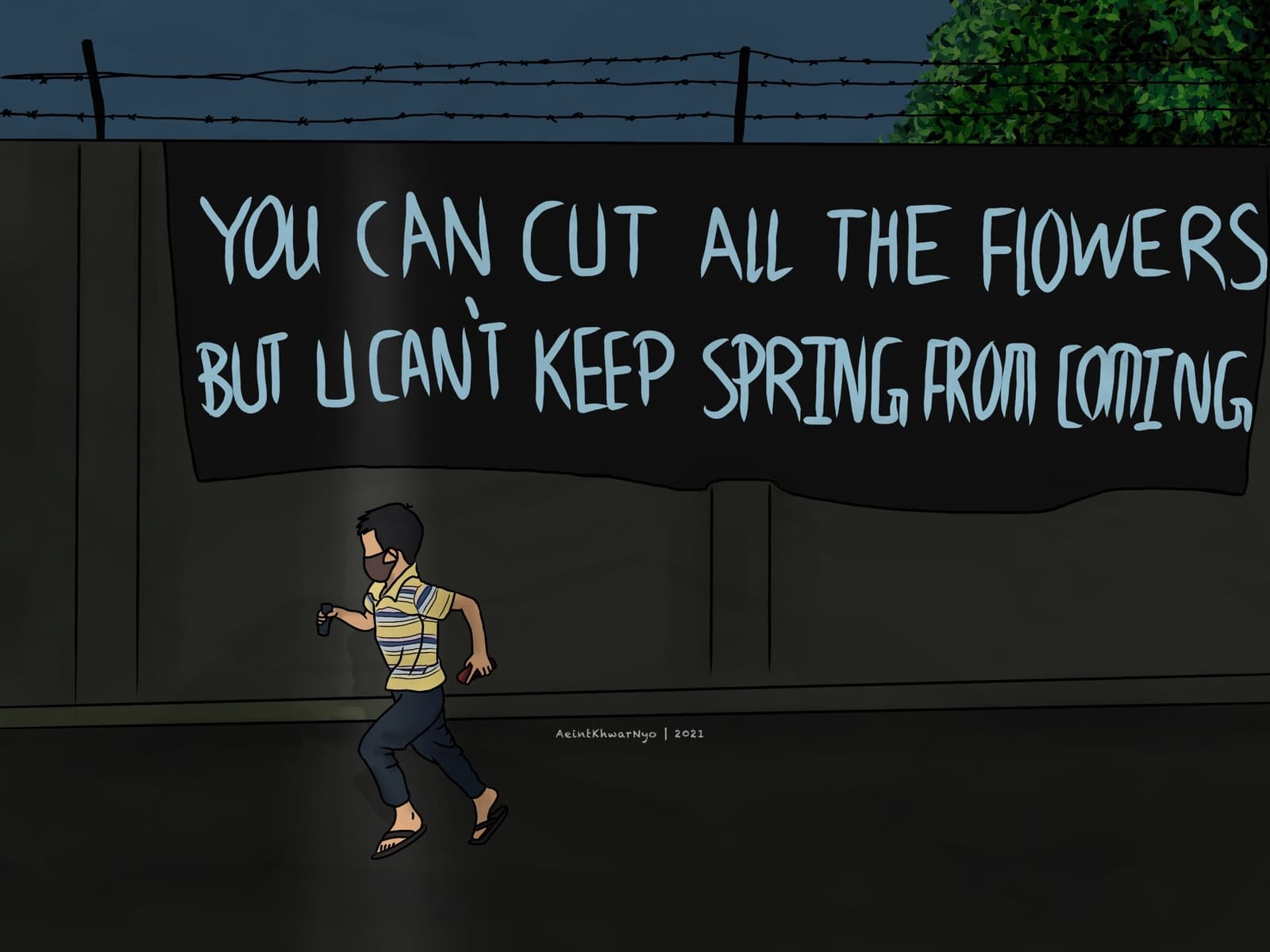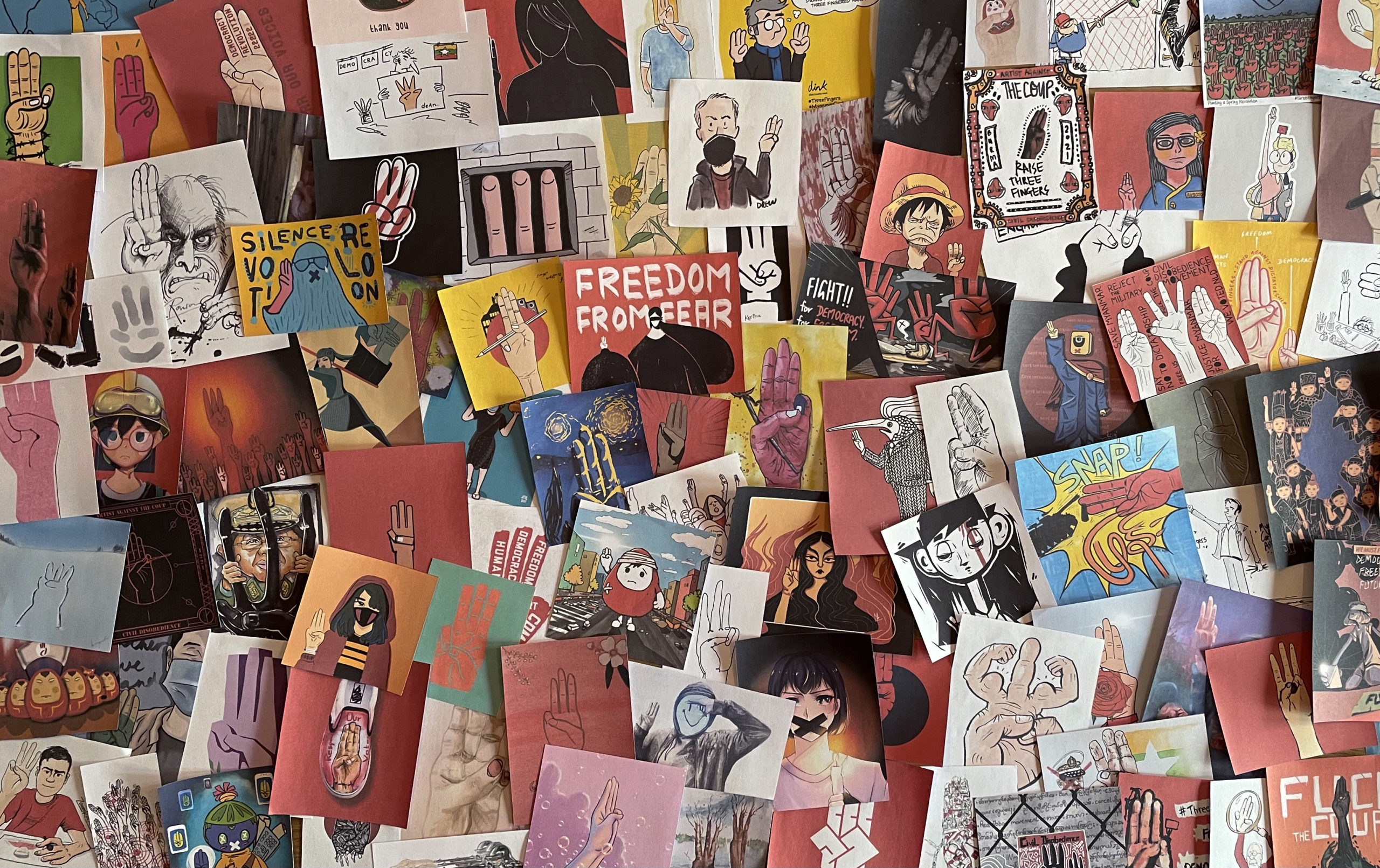To discuss the ongoing people’s revolution against the Tamadaw military’s coup of Myanmar, we spoke with the Raise Three Fingers art organization.
The group, named after the ubiquitous symbol used by protesters in Thailand and Myanmar, talks with us about making art during a revolution, surviving the violence of a military coup, and trying to express the idea of freedom.
Asia Art Tours: For the Three Fingers Symbol specifically, could you discuss how the gesture first started appearing in Myanmar? What does it means specifically in the context of Myanmar’s protests? And do you see the Three Fingers Symbol as part of a larger project of building solidarity with other democracy movements or freedom struggles?
Raise Three Fingers: Though the three-finger salute originates from the Hunger Games series, it has since evolved beyond simply being a pop-culture reference. The gesture has taken on a life and a language of its own. Now, it’s a symbol that is almost synonymous with resistance. Here in Myanmar, we saw it used in early protests, on signs, graffitied on the walls, in artwork, and on apparel. It’s powerful because you don’t need anything special – you can simply raise your hand to show your solidarity. It’s something you can carry with you.
For us, the three-finger salute is a symbol of unity, of strength, and of defiance against tyranny. It represents our desire to move beyond just returning to the status quo, and moving towards a federal democracy. We can’t go “back to normal” because that’s what got us here in the first place. We’re ready to start fresh, to build a country that is truly free and just for everyone.
It’s a really important marker of solidarity used by pro-democracy movements across the Milk-Tea nations, from Thailand to Hong Kong, Taiwan, and beyond. The emergence of groups like the Milk Tea Alliance reflect a regional desire for change and the responsibility to stand together with others who are fighting oppression, regardless of geographical borders.
 A drawing of a female protester raising the Three Fingers gesture. Photo Credit: RAISE THREE FINGERS
A drawing of a female protester raising the Three Fingers gesture. Photo Credit: RAISE THREE FINGERS
Asia Art Tours: Could you describe why your project began? What were its goals at the time and what do you see as its goals moving forward in both the near and long term future?
Three Fingers Myanmar: There was a huge outpouring of art in the wake of the coup on February 1st. People were making a variety of creative protest signs, digital art, graffiti, and shared memes on social media to defy and document what was happening. A Facebook page called Art for Freedom Myanmar was soon created, which became a platform for artists to share their artwork in an open source format for the public to use freely for the movement. Meanwhile, a group of filmmakers started Latt Thone Chaung, which means three fingers in Myanmar. They were using their skills to document the injustices taking place in the streets, interviewing people in mini-documentary style videos to tell the other side of the story, beyond what was being shown on national television.
Support from abroad started coming from the likes of the Professional Cartoonists Organisation (PCO) in the UK, whose members were making political cartoons to support Myanmar.These three groups – Art for Freedom, Latt Thone Chaung, the PCO, along with a team of passionate creatives and social change-makers in Myanmar – banded and gave birth to Raise Three Fingers.
Through Raise Three Fingers we aim to showcase this immense outpouring of creative resistance coming out of the country while calling upon the global art community to stand in solidarity with Myanmar in its fight for democracy, freedom and human rights. So far, we’ve amassed over 1,500 artworks from nearly 50 countries. We welcome art in any medium: we’ve had submissions including not just digital art and paintings, but also graffiti, sculptures, origami, photography, collage, mosaic, music, and even biscuits!
Currently, we’re doing a month-long poetry campaign calling for poems of hope, resistance, and solidarity for Myanmar, in honor of murdered poets K Za Win, Ma Myint Myint Zin, Khet Thi, and U Sein Win, as well as the over 30 poets currently in jail. Moving forward, we have plans to start selling art prints on our website to raise funds for the democracy movement and also support the artists in Myanmar who continue to fight with art despite the threats and challenges.
 A drawing from a real-life photo of a boy in Myanmar running past a banner quoting poet Pablo Neruda, who himself had connections to Myanmar. Photo Credit: RAISE THREE FINGERS
A drawing from a real-life photo of a boy in Myanmar running past a banner quoting poet Pablo Neruda, who himself had connections to Myanmar. Photo Credit: RAISE THREE FINGERS
Asia Art Tours: The violence the Tatmadaw (Myanmar’s military) has unleashed on citizens is well- documented, I am less familiar with what censorship has looked like in Myanmar post-coup. Could you discuss how the Tatmadaw has tried to censor dissent in art and media (print and digital)? And how are artists, poets, journalists within the country trying to circumvent this censorship to make sure their dissent is heard?
Raise Three Fingers: Censorship comes in many forms. The internet blackouts and blocking of social media sites pose a threat to our ability to stay connected, check in with loved ones, and get news out about what’s really happening in the country. The junta has also revoked almost all independent media licenses, and the nightly military propaganda news channel releases arrest warrant lists of those who are against the regime – including many creatives.
Artists, graphic designers, filmmakers, poets, bloggers, actors, singers, and social media influencers have already been detained, have warrants out for their arrest, are in hiding, or have fled the country, including our founders and many of the artists we work with. Nyan Kyel, who is one of the founders of Raise Three Fingers and Art for Freedom Myanmar, shares:
“The junta can unlawfully destroy our work, detain us or even kill us. We have to run and hide. We have to take action so that we can keep creating without being tortured by the junta—the terrorists. Most artists can’t even put their pen names to their art, let alone their real names. They have to be anonymous. I have been unlawfully issued a warrant for my arrest for breaching 505a, which targets critics of the junta. Their forces are after me. Although I’m hiding, I’m not safe at all. Anything can happen in a split second.”
Beyond digital and media censorship, arrest, and violence, artists also face self-censorship. Nyi Maw, one of the founders of Raise Three Fingers and Latt Thone Chaung, shares:
“What a dictatorship does to art is not only to limit what you can write, paint, rap or film. It goes much deeper. It drowns any thought or idea before it can even take root. When you live under constant fear and scrutiny, self-censorship becomes second nature. This is where art dies. You take fewer risks. You work only within the limits you’re given. You scrap an idea before it takes shape because you already know the Ministry of Culture will put a red line through your script. What’s the point then? Couple this with extreme poverty and limited access to resources, and it doesn’t leave much room for art to flourish.”
Though artists continue to circumvent censorship and subvert oppression in creative ways – using pseudonyms and working underground – it’s clear that life under a dictatorship will have a serious impact on society in general, and the creative and media communities in particular. We hope that through our work, we can keep art alive, keep the fighting spirit alive and build global solidarity for Myanmar artists, despite the junta’s attempts to censor and silence us.
 A Collage of’ Three Fingers’ Artwork. Photo Credit: RAISE THREE FINGERS
A Collage of’ Three Fingers’ Artwork. Photo Credit: RAISE THREE FINGERS
Asia Art Tours: Finally, how can artists help or support your project and those protesting in Myanmar? And how can we use art to build solidarity with Myanmar?
Raise Three Fingers: The fight for democracy, freedom, and human rights is everyone’s fight. And art has the power to propel this fight forward. It transcends language and borders, and has the power to motivate people to create change. We invite creatives around the world – whether you are a professional artist or an amateur – to create your own version of the three-finger salute, in any medium you like, and help raise awareness about what’s happening in Myanmar. Tag us @raise3fingers on Instagram, Twitter, TikTok, or Facebook, use the hashtags: #ThreeFingers, #FightWithArt, #WhatsHappeningInMyanmar, and upload your artwork to www.threefingers.org.
As news cycles shift and attention dwindles, we want to ensure Myanmar’s struggles are neither ignored nor forgotten; and that the people’s pleas for peace and democracy are heard. It’s important for us to keep the momentum strong – each and every artwork offers us hope and serves as a reminder that the world has our back.
For more on this and other organizing in Myanmar, head to: ThreeFingers.org
